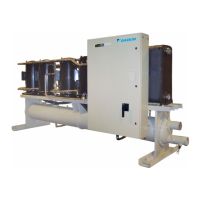IOM 1322 • WATER-COOLED SCROLL COMPRESSOR 10 www.DaikinApplied.com
Figure 3: Typical Evaporator Field Water Piping (WGZ030 - WGZ130)
Figure 4: Typical Evaporator Field Water Piping (WGZ150 - WGZ200)
It is important to have adequate water volume in the system to
provide an opportunity for the chiller to sense a load change,
adjust to the change, and then stabilize. The system water
volume is the total amount of water in the evaporator, air
handling equipment, and associated piping. As the expected
load change becomes more rapid, a greater water volume is
needed. If the water volume is too low, operational problems
can occur including rapid compressor cycling, rapid loading
and unloading of compressors, erratic refrigerant ow in the
chiller, improper motor cooling, shortened equipment life and
other undesirable occurrences.
For normal comfort cooling applications where the cooling load
changes relatively slowly, a minimum system volume of two
to three minutes times the ow rate (GPM) is recommended.
For example, if the design chiller ow rate is 120 gpm, we
recommend a system volume of 240 to 360 gallons.
For process applications where the cooling load can change
rapidly, additional system water volume is needed. A process
example would be the quenching of hot metal objects. The load
would be very stable until the hot metal is dipped into the water
tank. Then, the load would increase drastically.
Since there are many other factors that can inuence
performance, systems can successfully operate below these
suggestions. But as the water volume decreases below these
guidelines, the possibility of system instability increases.
Reducing chilled water ow in proportion to load can reduce
total system power consumption. Certain restrictions apply to
the amount and rate of ow change. The rate of ow change
should be a maximum of 10 percent of the change, per minute.
For example, if the maximum design ow is 200 gpm and it will
be reduced to a ow of 140 gpm, the change in ow is 60 gpm.
Ten percent of 200 gpm equals 20 gpm change per minute, or
a minimum of three minutes to go from maximum.

